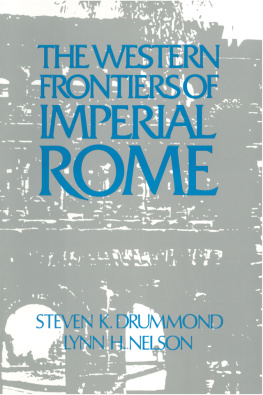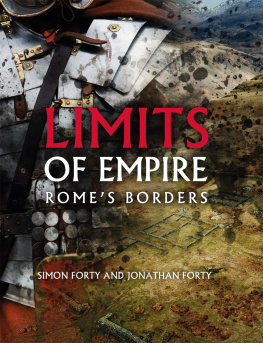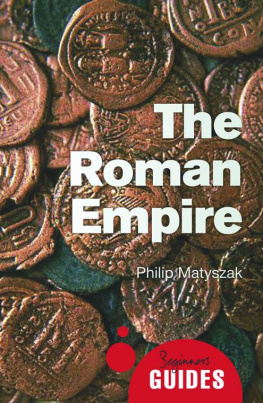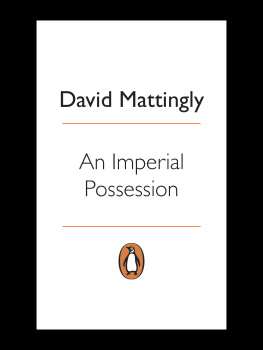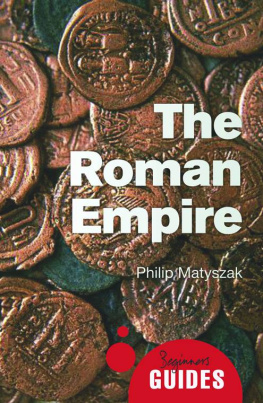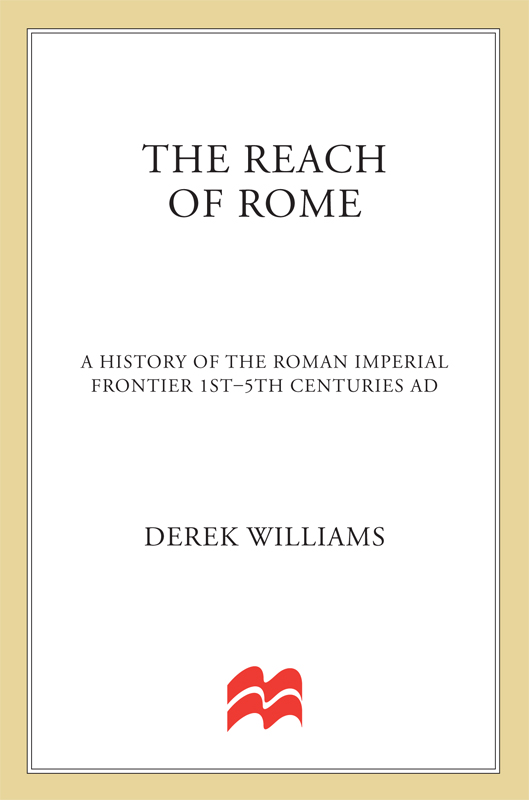Contents
Guide

The author and publisher have provided this e-book to you for your personal use only. You may not make this e-book publicly available in any way. Copyright infringement is against the law. If you believe the copy of this e-book you are reading infringes on the authors copyright, please notify the publisher at: us.macmillanusa.com/piracy.
CONTENTS
To our grandchildren
Alex, Elly and Becky
Imperial Frontiers: Hadrianic Period
Maps and diagrams drawn by John Mitchell
Among many to whom I am in debt, precedence must be given to the organisers of and contributors to the Congresses of Roman Frontier Studies and the publishers of the successive volumes of their proceedings, almost all of which have been drawn upon, some extensively. The foundations of our subject lie even deeper, at the level of local archaeology and the regional antiquarian journals; but it was the Congresses which brought together scholars at international level, allowing an empire-wide view of the frontiers to emerge from the national fragments at last. A glance at my footnotes will show that their papers are the heart of the frontier discussions in this book.
I would like to thank all authors of works mentioned in my text or notes. I am especially grateful to the general editors of the British Archaeological Reports, Oxford, their individual authors, and editors of the colloquia, conferences or collected articles. This valuable series has highlighted the work of some of the most able scholars of our day in archaeological and related fields.
A number of distinguished works, not mentioned in my notes, have been of general value. These include: S. L. Dysons The Creation of the Roman Frontier (Princeton, 1985), which provides essential background on European frontier formation during the Republican period; F. Millar and others, Das Rmische Reich und seine Nachbarn (Frankfurt, 1966), which places the empire in its surroundings; J. B. Campbell, The Emperor and the Roman Army (Oxford, 1984) on the relationship between soldiers and centre; Roman Civilization, Sourcebook 2, the Empire (New York, 1966) in which N. Lewis and M. Reinhold present and translate a wealth of source material; E. Luttwaks The Grand Strategy of the Roman Empire (Baltimore, 1976), an influential treatment of achievement in diplomacy and war; R. Martins Tacitus (London, 1981), which enriches our view of Romes most memorable historian; C. R. Whittakers Frontiers of the Roman Empire: A Social and Economic Study (Baltimore, 1994), which makes a notable contribution to the subjects theoretical background; and Stephen Johnsons fine study of the military and paramilitary scene in 3rd- and 4th-century Western Europe, Late Roman Fortifications (London, 1983).
In the matter of translation from the modern languages I accept responsibility for all passages quoted but wish especially to thank Miss Muriel E. Hammond for assistance with a significant number of the reports and papers in German. Regarding the ancient languages, I owe a debt to the editors, publishers, textual scholars and translators of the Oxford Classical, Teubner and Bud series; and, above all, to the Loeb Classical Library, whose Greek and Latin texts often provided the basis for my own translations used throughout this book. The Loeb English versions, by scholars far more accomplished than myself, offered a frequent reassurance for my parallel efforts. In general, however, I have leaned further towards free translation. My objective has been to produce flexible renderings and to adapt these into a fluent narrative. I apologise for telescoping texts and occasionally combining passages into composite quotations. Nevertheless I have tried, like all sincere translators, not to lose the essence of the originals.
The ancient sources most frequently quoted are Dio Cassius History of Rome, the principal works of Tacitus, the Augustan History, Ammianus Marcellinus History, Strabos Geographica and Plinys Natural History. These are available for wider reading in the Loeb Classical Library and, in several instances, in the Penguin Classics editions. A number of the minor sources are still unavailable in translated form.
O. Seeks edition of the Notitia Dignitatum (Berlin, 1896); the Theodosian Code (trans. C. Pharr; Princeton, 1952); Zosimus New History (San Antonio, 1967) and de Rebus Bellicis (ed. M. W. C. Hassall; London, 1979) are among the source books consulted. Chapter and page numbers in Gibbons Decline and Fall refer to the 1811 edition, which chanced to be the version of that great work at my disposal.
Quotations from Fossatum Africae are by kind permission of its publisher, Arts et Mtiers Graphiques, Paris.
I am indebted beyond measure to Caroline Davidson, literary agent, whose perceptive and thoughtful comment on my original draft resulted in extensive reshaping and necessary improvements. Also to Dr Andrew Dalby for careful reading and helpful suggestion. Their structural recommendations exercised a decisive influence on the books final form. Susan Trevelyans and Anne Charvets searching and constructive reading of the typescript yielded a torrent of improvements. All have been immensely helpful, but the book would not have seen daylight were it not for Carol OBrien, of Constable and Co., whose readiness to back an outsider to the academic field was an act of perspicacity and pluck of which I hope my efforts will prove worthy.
I would next like to thank the president, secretary and librarians of the Society for the Promotion of Roman Studies, London, within whose walls and with whose volumes on loan I have passed happy hours; and whose collection of books was the key to the production of this one. I also wish to thank Kathy Clark and Samantha Hopkins for lifting my ungainly manuscript to the level of a clean, clear typescript and for unremitting vigilance regarding errors.
On a more personal note, it gives me pleasure to thank Professor J. A. Robinson of Syracuse University for encouragement and counsel. His inspiration in tracing and telephoning me, following an almost forty-year loss of contact, led to the renewal of an old friendship coinciding precisely with the writing of this book.
I have abiding gratitude and fondness for the memory of my teachers at the best of schools and the greatest of universities. At the Royal Grammar School, Newcastle upon Tyne, Sydney Middlebrook gave me the love of history and Maurice Guy Robinson of letters; Hugh Owen, H. N. Smith and James Herdman equipped me with the ancient and modern languages and Donald Meaken the geographical grasp, without any one of which I would not have dared attack this summit. At Corpus Christi College, Cambridge, Patrick Bury extended and deepened the historical sense. Bruce Dickens, an eminent Anglo-Saxonist, gave encouragement to my interest in Romano-British studies, then little more than a hobby. Michael McCrum, in addition to friendly support, helped greatly in opening my eyes to the Classical world of the Mediterranean, not least by recommending me to the British School at Athens. Alas, of all these fine teachers only the last now survives. It is a sad consequence of writing a book late in life that so many to whom one owes so much are no longer here to be thanked.
Though my father too did not live to see this book, I owe him and my mother infinite gratitude for their long, loving and patient support, reaching back to youthful days, with many a dawn call for outings to Hadrians Wall and car rides to and from Roman locations.


